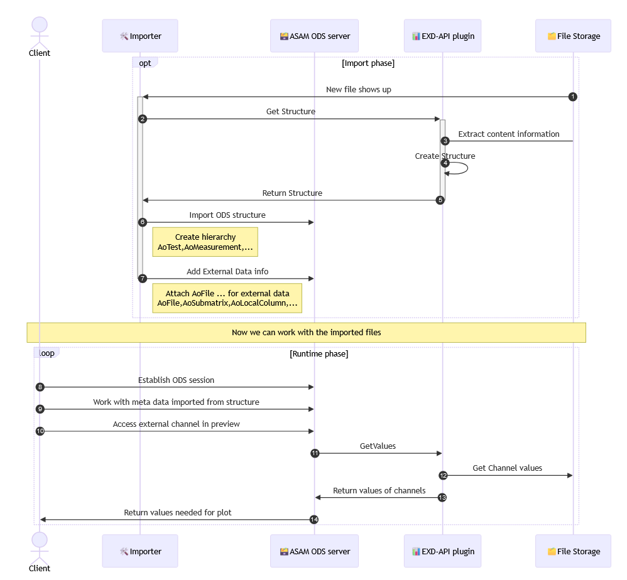EXD-API Plugins Overview#
The conversion of legacy data into standard data formats often requires data conversion. This can lead to an increased volume of data due to data copies and to an interruption of existing tool chains that use this data.
To avoid these conflicts, ASAM ODS has introduced the External Data API with version 6.2. The External Data API enable access to legacy data through microservices that expose the metadata and mass data they contain we call such a service an EXD-API Plugin.
As a member of the ASAM ODS working group, Peak Solution was significantly involved in the definition of External Data API and the Peak ASAM ODS Server has supported the External Data API from the very beginning.
Working principle of EXD-API Plugins#
EXD-API Plugins exchange data via the Google gRPC protocol.
The data provided by the EXD-API Plugin splits into two different operations: meta data retrieval (GetStructure) and bulk/channel data retrieval (GetValue). The meta data is returned in form of name-value pairs and is used to provide descriptive and semantic information about the data and so offering extended searching capabilities.

Looking at a typical calling sequence, you can see that once a new file (or data item) has been detected (1), the EXD-API Plugin is called (GetStructure) by the importer to deliver the meta data of that specific file (2). The EXD-API Plugin then reads the file (3), creates the return structure (4) and returns the requested data (5). One part of the returned meta data - often in combination with the file and the folder name - is then being used to identify and create the data context, respective the needed data hierarchy (6). The other part is then being used to create the data structure in the server for receiving the bulk/channel data in subsequent calls and for (optionally) providing the file for download (7).
Now all needed data and information is available in the ASAM ODS server, such that clients can start using the data. To do so, they connect to the ASAM ODS server (8) and typically start explore the hierarchical data structure (9) until the point is reached accessing the actual channel data (10).
To access the channel data, the ASAM ODS server delegates the client call to the EXD-API Plugin (11) by calling GetValue - including information about the file and the channel(s) in request. The EXD-API Plugin use this information to open the file, retrieve the data (12) and return it to the ASAM ODS Server (13) which relays it back to the client (14). From the client perspective there is no difference between a call directly handled by the ASAM ODS server or delegated to an EXD-API Plugin.
Existing EXD-API Plugins#
You can find a list of publicly available EXD-API Plugins in the Peak Solution GitHub repository.
Developing EXD-API Plugins#
Developing an EXD-API Plugin starts with getting the gRPC definition file (.proto file) from the ASAM GitHub repository. Use the gRPC tools to generate the initial server code from the .proto file. The gRPC tools support many different programming language and you best choose a programming languages which already provides a library for the file or data format you want to create your ExD Service for.
The ease-of-use and rich eco system makes Python a popular programming language for writing gRPC services and you can find some examples of Python based EXD-API Plugins like the MDF4 EXD-API Plugin here or in the totonga GitHub repository.
Please note, that once you’re done programming your EXD-API Plugin, it must be registered with the ASAM ODS Server and the according import service to make your data show-up in an ASAM ODS server eventually.
You can test your EXD-Plugin using this Notebook: 📓 Test ASAM ODS EXD-API Plugins
License#
Copyright © 2025 Peak Solution GmbH
The training material in this repository is licensed under a Creative Commons BY-NC-SA 4.0 license. See LICENSE file for more information.
Notebook: 📓 Back to course overview

